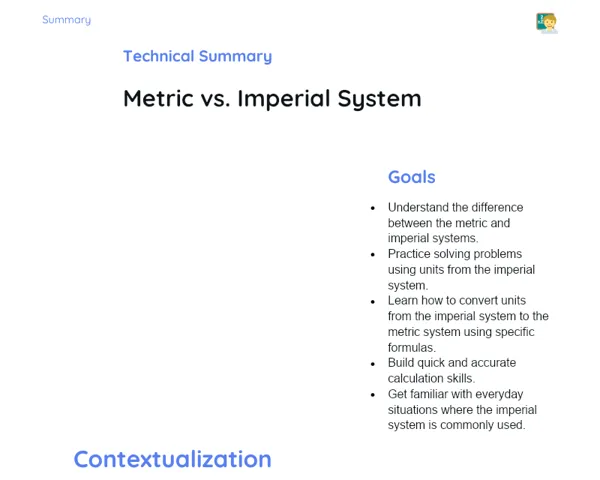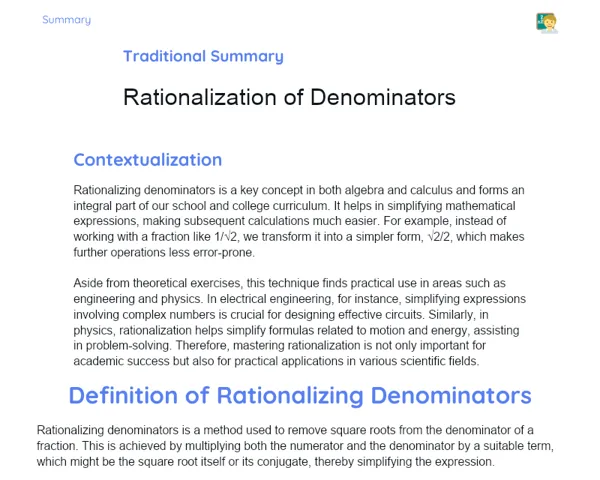Objectives
1. Recognize when two fractions do not share the same denominator and convert them to a common denominator using the concept of equivalent fractions.
2. Develop logical reasoning and critical thinking skills while solving mathematical problems involving fractions.
Contextualization
Did you know that fractions have been in use since ancient times to tackle practical issues? For instance, the ancient Egyptians employed fractions to divide land and calculate taxes. This highlights how fractions are vital not just in mathematics but also in our daily lives. Grasping and manipulating fractions, especially when working with common denominators, will aid in tasks like adjusting cooking measurements or splitting costs, making mathematics much more approachable and relevant!
Important Topics
Fractions and Denominators
Fractions represent parts of a whole and are made up of a numerator (the part we have) and a denominator (the total). When performing operations such as addition or subtraction with fractions, it is essential for the denominators to match, leading us to the concept of common denominators. Finding a common denominator among fractions enables us to carry out arithmetic operations effectively, enhancing understanding and problem-solving.
-
Common Denominator: A number that is a multiple of all the involved denominators. Identifying a common denominator is crucial for adding or subtracting fractions.
-
Operations with Fractions: For adding or subtracting fractions, all denominators must be identical. This is achieved by deriving equivalent fractions with common denominators.
-
Equivalent Fractions: These are fractions that signify the same value but are displayed differently. Converting fractions to equivalent forms with common denominators eases calculations.
Equivalent Fractions
Equivalent fractions are those that, although written differently, represent the same quantity. For example, 1/2 and 2/4 are equivalent as both denote half of a whole. Recognizing and utilizing equivalent fractions is key when working with fractions in mathematical operations, especially in the quest for common denominators.
-
Importance in Mathematics: Employing equivalent fractions simplifies calculations and enhances understanding of mathematical relationships, like comparing sizes.
-
Converting Fractions: Multiplying or dividing both the numerator and denominator by the same number yields an equivalent fraction. This is particularly useful for adjusting fractions to new common denominators.
-
Practical Applications: Finding equivalent fractions proves beneficial in various contexts, such as resizing recipes or equally distributing resources.
Operations with Fractions
Adding, subtracting, multiplying, and dividing fractions are fundamental operations that necessitate a solid grasp of equivalent fractions and common denominators. During these operations, it is vital for the denominators to be the same for the calculations to be executed accurately. This concept is applicable in many everyday situations like cooking or dividing quantities.
-
Addition and Subtraction: For adding or subtracting fractions, the denominators have to be the same. If not, the fractions should be converted to equivalents with common denominators.
-
Multiplication and Division: In these cases, the denominators don't need to match, though simplifying the fractions beforehand can make the calculations easier.
-
Practical Applications: Mastering operations with fractions is essential for daily tasks, such as computing discounts during shopping or preparing mixtures in accurate proportions.
Key Terms
-
Fraction: A part of a whole, depicted as a numerator over a denominator.
-
Common Denominator: A number that is a multiple of all denominators involved in fractions that are being added or subtracted.
-
Equivalent Fractions: Fractions that express the same value but are articulated differently, typically with different denominators.
For Reflection
-
Why is it significant for denominators to be equivalent when adding or subtracting fractions? How does this simplify the math?
-
How can the concept of equivalent fractions and common denominators be applied in everyday scenarios, like in cooking or sharing costs?
-
What is the connection between the ability to work with equivalent fractions and the capacity to solve more complex math problems in different areas of study?
Important Conclusions
-
In this lesson, we delved into the concept of fractions and highlighted the necessity of common denominators for effective mathematical operations. Recognizing and creating equivalent fractions is vital for many practical applications, from modifying cooking recipes to sharing expenses.
-
We realize that the mathematics of fractions is not purely numerical, but rather about applying these concepts to resolve everyday challenges more efficiently.
-
Being able to effectively work with fractions also fosters logical and critical reasoning, which are fundamental skills not only in mathematics but across various areas of life.
To Exercise Knowledge
- Modified Recipe: Select a simple recipe and adjust the ingredient amounts using equivalent fractions. For instance, if a recipe requires 1/2 cup of flour, try using 1/4 and 1/8 and calculate the requisite amounts for each ingredient. 2. Fair Division: Suppose you and two friends order a pizza. Divide the total slices evenly among yourselves, but utilize fractions with different denominators to ascertain if everyone gets an equal share. 3. Expense Diary: Maintain a diary for your expenses over a week and at the close of each day, compute the percentage of your total expenses against a predetermined amount. This exercise helps in practicing the conversion of fractions to percentages and vice versa.
Challenge
🌟 Chef-Frac Challenge: Design your recipe employing fractions! For instance, create a new juice blend using 1/3 orange juice, 1/4 apple juice, and 1/6 pineapple juice. Then, calculate the total for each ingredient for various quantities of final juice, and modify the recipe to serve 10, 20, and 30 persons.
Study Tips
-
Regularly engage with online games or math apps focusing on fractions and their operations. This approach can make learning more enjoyable and interactive.
-
Attempt to explain the concept of fractions and equivalent fractions to someone at home. Teaching can significantly reinforce your understanding and uncover areas that need more attention.
-
Utilize fraction cards for visualizing and practicing operations with fractions. This method can help make concepts more tangible and easier to grasp.



